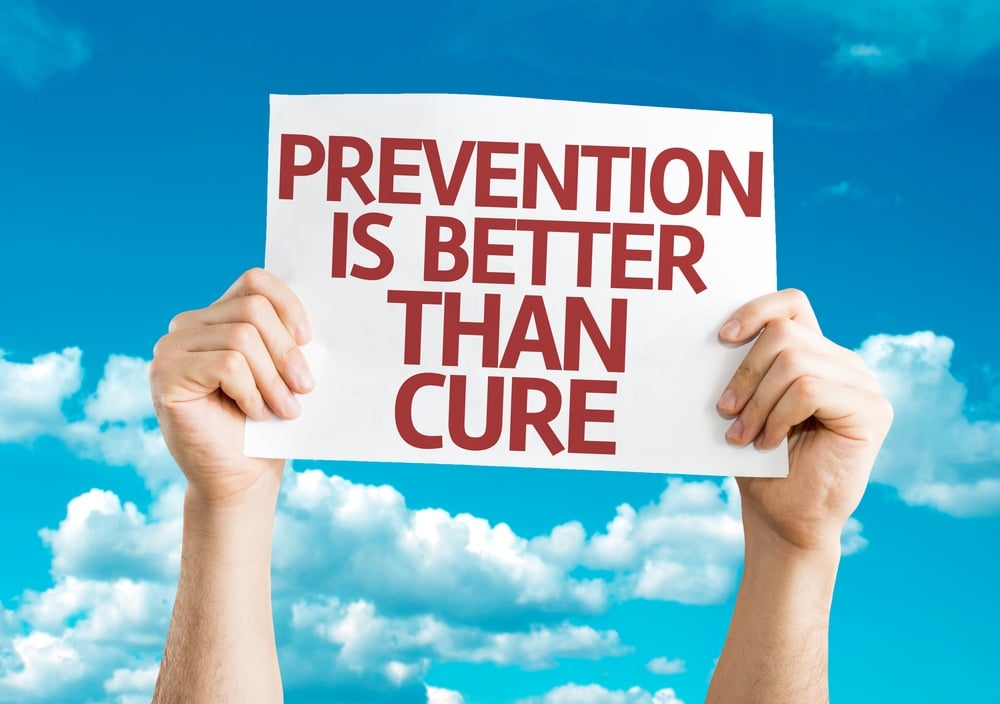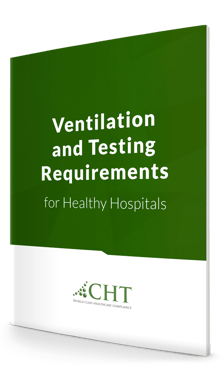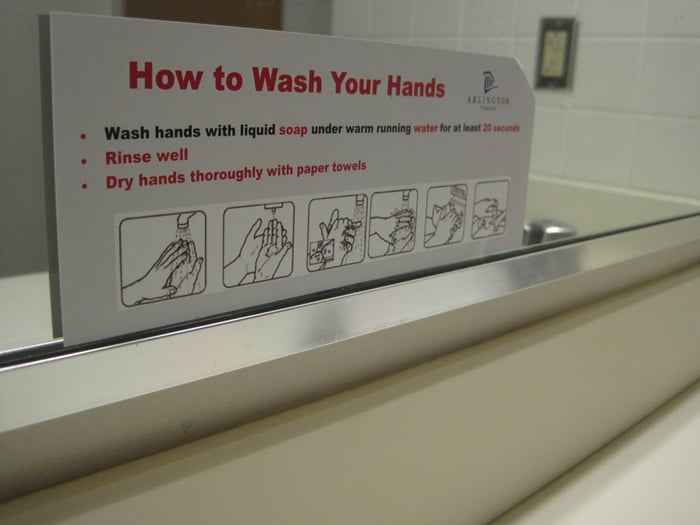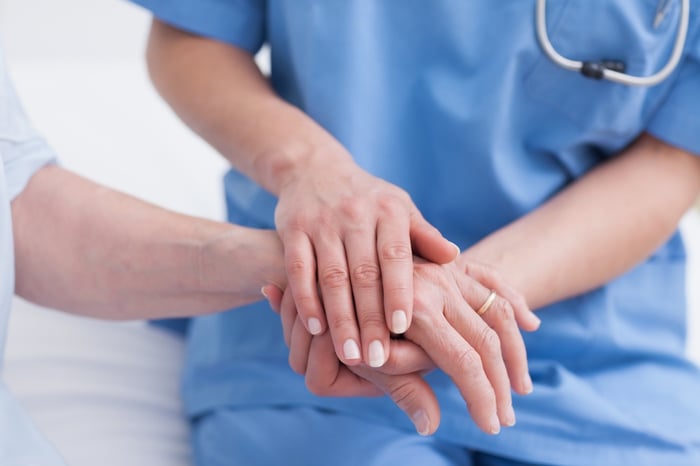
Keeping your medical gas systems operating properly isn't the only challenge that affects patient safety.
It is about time that these formerly Hospital Acquired Infection or Hospital Associated Infections were seriously attacked.
These infections have been responsible for almost 100,000 deaths and cause an estimated 1.7 million illnesses in the United States per year. (source)
Nosocomial infections kill more Americans each year than AIDS and breast cancer combined. So, the counterattack has begun to save lives and patient distress.
Nosocomial (nōzōˈkōmēəl) comes from two Greek words:
nosus, meaning "disease", and
komeion, meaning "to take care of."
So, it is a disease or infection from being taken care of (while under medical care).
The terms Hospital Acquired Infections, Hospital Associated Infections, HAI, or Nosocomial Infections will be used interchangeably throughout this article.

Sneak Attack to Overcome or Fight HAIs
Sadly, about 5% of the people who were admitted to the hospital got a nosocomial infection, and most of them were never in intensive care.
Long-term care, rehab facilities, and even surgery centers can harbor pathogens that attack exposed folks.
The most common infections were:
- Bloodstream infections (BSI)
- Catheter-associated urinary tract infections
- Ventilator-associated pneumonia
- Surgical site infections (SSI)
Mechanical ventilation, catheter insertion, some invasive procedures, and neonatal departments are more frequent sources of nosocomial infections (HAIs). (source)
A recent study into the economic burden of healthcare-associated infections found that,
HAIs not only led to increased morbidity and mortality but also impose a significant financial burden on the health system. The estimated direct annual cost of treating HAIs in the United States ranges from $ 28.4 billion to $ 45 billion, resulting in a heavy burden on the public health system. (source)
The Center for Medicare and Medicaid Services (CMS), the biggest payer of healthcare bills, wanted to make some changes to reduce the incidence and severity of these cases. The first effort was to track how frequently the infections occurred and how severely they hurt the patients (therefore, how much they cost to fix). (source)
The preliminary research indicted hospitals, but more frequently, the ambulatory sites that connected patients over and over again to equipment for infusion and chemical treatments.
Approximately 50% of ambulatory surgical centers (ASC) surveyed by CMS and CDC had serious noncompliance with the Medicare ASC health and safety standards, and 28% had unsafe injection practices. (source)
Patient, therapy, and environment characteristics that are associated with HAIs include:
- Patients older than 70 years
- Shock
- Major trauma (like auto accident or violence)
- Acute kidney failure
- Coma
- Prior heavy use of antibiotics
- Mechanical ventilation (tracheotomy)
- Treatment that can affect the immune system (Steroid usage or chemotherapy)
- Indwelling catheters
- Prolonged ICU stay (>3 days).
- Premature newborns with complications
In 2008, CMS and others decided to make rules that affected the reimbursement for the treatment of nosocomial infections. Partially because the costs were getting too high and partially because there were hospitals that had much lower rates of infection than others, this disparity in rates demonstrated that methods existed that reduced rates and associated costs of nosocomial infections.
The difference between facilities with high and low incidence of HAIs was examined.
This is what was found in facilities with low incidence rates,
- Care providers clean their hands before and after caring for every patient.
- Catheters being used only when necessary and removed as soon as possible.
- Antiseptically cleaning around the catheter or the surgical site before insertion.
- Care providers wore full PPE when appropriate.

image credit: Hand washing
Follow-up studies of locations with high rates of nosocomial infections indicated the first line of attack was the sanitation of the attending staff, the facility, and the equipment people were being treated with.
By shadowing staff during their workday, it was found that washing hands, wearing personal protective equipment, and completely disinfecting patient facilities as well as equipment could dramatically reduce the incidence of infection.
There is a great need for hospitals, public health authorities, certifying organizations, and even payers to scrutinize room and equipment disinfection methods. For many superbugs, the biggest risk factor can be the room the patient is assigned to. If a previous patient in a hospital room, even a month before, had a superbug infection, the risk to the current occupant is noticeably increased. New technologies make it possible to continuously destroy funguses, bacteria, and viruses in rooms in ways that are not harmful to patients.
Sanitizing surfaces by Environmental Services staff is critical to reducing HAIs in hospitals, but perhaps even more so in surgery and ambulatory care centers because of the number of different people using the same rooms and equipment in a day.
Microorganisms are known to survive on inanimate "touch" surfaces for extended periods of time. This can be especially troublesome in hospital environments, where patients with immunodeficiencies are at enhanced risk for contracting nosocomial infections.
Of course, there is great pressure to “turn around” rooms or treatment areas quickly to maximize the amount of care that can be delivered. Surveys have shown that even minute amounts of material left by previous patients can lead to these infections.
Cleaning must be done thoroughly and with adequate time for the chemicals to work.
A disinfectant takes three to four minutes in a liquid state to completely eliminate pathogens. A quick wipe with a damp towel does not clean. Likewise, all the surfaces that patients or staff may touch need to be cleaned, including the underside of bed rails, electronic devices, and cords/tubing coming from devices to the patient, in addition to counters, handles, and bathrooms.
Using hydrogen peroxide-based cleaners has been clinically proven to reduce infection rates and risk of HAI acquisition. Hydrogen peroxide as part of the regular cleaning solutions has been effective against bacteria such as C. diff (Clostridium difficile), where alcohol-based cleaners have been shown to be ineffective. Another improvement is the use of ultra-high-intensity UV lights to sterilize rooms after the chemical cleaning. While this adds to room turnaround time, the light seems to kill pathogens cleaners miss.
MRSA or C. diff infection rates can be a red flag that a hospital isn’t following best practices in preventing infections and prescribing antibiotics. These signs of poor hand and facility hygiene can turn the hospital into a breeding ground for other resistant infections that are even more difficult to treat. Numerous studies have shown that even “invisible” amounts of debris from one patient can be transferred to ensuing patients from the hands, unchanged gloves, the bed, and linen in a hospital room. Some of the high-performing hospitals even changed the curtains between beds with each cleaning.
The infections most often found in the studied hospitals were:
- Pneumonia
- Urinary tract infection
- Surgical-site infection
The Battle Begins Against Nosocomial Infections

The healthcare attacks to eliminate nosocomial infections took on three targets in the short term:
- Training and reinforcement that anyone that touches the patient or anything that touches the patient must wash their hands or use an alcohol-based antibacterial cleaner before and after contact is made.
- Environmental services had to be trained and disciplined to use stronger sterilizing solutions and thoroughly clean every surface the patient would touch.
- Any equipment entering or attached to the patient had to be sterilized before use and not be reused, even in ongoing care inconvenience events. Including any instruments, linens, or equipment that had been contaminated by any kind of bodily fluids.
Today, these guidelines seem like obvious and straightforward rules, but they severely complicated the routines of most healthcare workers. Not only were staff, including physicians, not comfortable changing their methods, but these new methods took longer and seemed less personal in delivering the healing, comforting service of a nurse or a doctor.
Likewise, taking extra time and using more expensive chemicals to sanitize rooms and other care sites added costs and slowed productivity. Reusing equipment on the same patient was easier, faster, and cheaper than opening a new package and reinstalling and connecting when the patient had to be moved or required changing. For all these reasons, the comfortable old way had to be changed to save the patient from death, disease, and the cost of secondary care. Change among personnel in any setting is a very big challenge.
Sadly, one study found even with new guidelines and instructions, conformance to the new rules ran about 40% for the hands-on staff and a similar amount in the surgery areas. As the studies in various hospitals continued, the proof of the efficacy of hand hygiene and other methods became overwhelming. Pressure from medical reimburseers and the government began to build as the information became more public that procedural changes could save lives, ease patients' recovery, and reduce costs.
Another factor was the increasing business orientation of the industry. Professionals in finance and management, especially in larger organizations, could see the macro value of controlling the additional costs.
Symptoms that Define Nosocomial Infections
The infection must occur:
- up to 48 hours after hospital admission
- up to 3 days after discharge
- up to 30 days after an operation
- in a healthcare facility when someone was admitted for reasons other than the infection
Nosocomial infections are caused by bacteria, fungi, and viruses. Bacteria alone cause about 90% of these cases. People whose immune systems are compromised during their hospital stay by trauma or drug treatments are more likely to contract an infection.
The federal Health and Human Services Department set an Action Plan for Hospitals to reduce the following infections.
HAI (Nosocomial Infections) Priority Areas
- Catheter-associated urinary tract infection
- Central line-associated bloodstream infection
- Surgical site infection
- Ventilator-associated pneumonia
- MRSA
- Clostridium difficile
As a result, in some areas, groups of hospitals got together to work out the details of teaching and enforcing the new routines in surgical, treatment, and palliative care areas. The synergy among colleagues produced great results as they worked in a cooperative fashion between institutions to solve a common problem. For the most part, the equipment and technologies were available to everyone. It was the method of care and treatment that needed to be changed to deliver safer, less complicated care to the patients. Changing employee’s behavior and attitudes is always harder than getting new equipment. The results from groups in the Pittsburgh and Michigan areas were very impressive.
By working as cooperative, semi-competitive groups, they reduced HAIs by about one-third and bloodstream infections by 66%. Not only were these test areas proud of their progress, but it got the attention of the national certifiers and reimbursers to use the techniques these groups found in hospitals and ambulatory care facilities all over the country.
World Health Organization's Five "Moments" for Hand Hygiene
- Before touching a patient (IB) – to protect the patient from harmful germs carried on your hands
- Before aseptic procedures (IB) – to protect the patient against harmful germs, including the patient's own germs
- After body fluid exposure/risk (IA) – to protect yourself and the health care environment from the harmful patient's germs
- After touching the patient (IB) – to protect yourself and the healthcare environment from the harmful patient's germs
- After touching the patient's surroundings (IB) – to protect yourself and the health care environment from the harmful patient's germs.
(There are two moments before and three moments after touching the patient).
How?...
- Wash hands with soap and water when they are soiled or visibly dirty with blood or other body fluids. Wet your hands, apply soap, and then scrub them vigorously for at least 15 seconds. Cover all surfaces of the hands and fingers, wash with water, and then dry thoroughly using a disposable towel.
- Use an alcohol-based hand rub, e.g., 0.5% chlorhexidine with 70% w/v ethanol, if hands are not visibly dirty. A combination of chlorhexidine and alcohol is ideal as they cover Gram-positive and Gram-negative organisms, viruses, mycobacteria, and fungi. Chlorhexidine also has residual activity.
- During surgical hand preparation, all hand jewelry (e.g. rings, watches, and bracelets) must be removed.
- Fingernails should be trimmed to <0.5 cm with no nail polish or artificial nails.
- Avoid wearing long sleeves, ties should be tucked in, house coats are discouraged, and wearing scrubs is encouraged.
Front Line Counter Attack Against Hospital Acquired Infections

Nurses and nursing assistants are on the front line in the battle against HAIs.
They are in contact with the patient and the patient’s surroundings more than anyone. The studies to reduce infections and to put numbers on the conformance to new standards are studying nurses most often for this reason.
While hand hygiene is the easiest and most effective way to reduce HAIs, nurses provide many different contact points with the patient. Any treatment that involves contact with bodily fluids should be a caution sign to protect the nurse and the patient. This may involve wound treatment, but much more often, the inserting of lines or attaching ports, catheters, even canellas, or other equipment. Studies have shown that patients can be infected by exposure to their own expelled material. When one action involving bodily fluids is complete, gloves should be changed before going on to an additional service on the same patient.
In this regard, intravenous therapy is a huge area of concern with HAIs.
Almost half of HAIs are linked to invasive devices, such as urinary catheters, central lines, and ventilators, or surgery. Not only are the therapy fluids going into the patient, but potentially infectious agents may come from or be on the skin of the patient. This makes antiseptic cleaning of these insertion areas mandatory before both insertion and removal.
Nurses can play a major role in reducing these infections, leading and participating in prevention efforts. Nurses collaborating with infection preventionists, physicians, quality-improvement specialists, pharmacists, and others have demonstrated a significant decrease in HAIs. Using the combination of professional experience and innovative caring efforts, they reduced the HAI impact on patients, families, nurses and other caregivers, and hospital bottom lines.
Victory in Sight - Seeing is Believing
Can you use the “ick factor” to get healthcare workers to clean their hands more often?
Yes... according to a study presented in June 2016 at the 43rd Annual Conference of the Association for Professionals in Infection Control and Epidemiology. (source)
"The infection control team at Henry Ford Health System in Detroit, Michigan, used images of bacterial growth to provoke feelings of disgust and motivate hospital staff to comply with hand hygiene guidelines. The team developed a book of images containing bacterial cultures of differing types and levels of contamination, as measured by Adenosine Triphosphate (ATP) meter readings."
"They tested the images on hospital units that had low hand hygiene compliance rates, and over a two-month period, they visited those units 10 times, sampled workers’ hands for bacteria, and then showed them pictures of cultures similar to the contamination on their hands. Compliance increased by between 11 and 46 percentage points in units where the study was conducted."
“Hospital staff wanted to wash their hands after looking at the book and picturing similar contamination on their own skin,” said Ashley Gregory, MSL (ASCP), an infection prevention specialist who co-led the project. “Using this example, other institutions may be able to change behavior and improve their hand hygiene compliance rates by influencing staff to connect the images of microbial contamination with non-adherence to hand hygiene guidelines.”
"The program also motivated healthcare personnel (HCP) to take ownership of the environmental cleaning of their workspace. By comparing the ATP readings taken from phones, mobile work stations, and computer mouse devices to the photos in the book of germ images, HCP were able to visualize the contamination on the surfaces surrounding them."
“Hand hygiene is one of the most important ways to prevent the spread of infection, and yet it can be one of the most difficult benchmarks to improve,” said APIC 2016 President Susan Dolan, RN, MS, CIC, hospital epidemiologist, Children’s Hospital Colorado. “The visual nature of this approach proved successful for the team at Henry Ford Health System, and it may offer an effective strategy for other healthcare facilities that are looking for ways to change behavior and improve hand hygiene compliance.”
"Embedding a new approach often requires a major culture change but by early 2006, an emerging statistic caught everyone’s eye,” says Joe McCannon, manager of the 5 Million Lives Campaign and an Institute for Healthcare Improvement Vice President. Hospitals participating in the campaign had not only significantly reduced their monthly HAI rates, in some months all the way down to zero, but “a surprising number were getting down to zero and staying there.”
One such hospital is Barnes-Jewish Hospital at Washington University Medical Center in St. Louis, Missouri’s largest teaching hospital with 1,228 beds. Denise Murphy, RN, MPH, CIC, Vice President for Safety and Quality, insists that, for change to stick, a hospital has to revamp its culture as well as its procedures. She says, “You have to get your mind and heart in the right place, too.” Murphy says that place is not just zero infections but “zero tolerance for non-compliance with proven prevention measures.”
A past president of the Association for Professionals in Infection Control and Epidemiology (APIC), Murphy says that many hospitals simply measure themselves against national averages, such as three infections per 1,000 patient days. “If hospitals do as well as or slightly better than their peers, they are satisfied.” That sets the bar way too low, she argues.
“The right benchmark is always zero,” she insists, because “every infection is someone’s loved one. If you know the protocols required to avoid infection, if you follow them precisely every single time, then zero infections are possible. When you’re talking about something that can cost people their lives, and zero is possible, no other benchmark makes sense.” (source)
Conclusion
Modern healthcare is fighting a battle against all the diseases in the world, with human beings on the front line. The enemy is constantly shifting and changing.
Researchers and front-line treatment staff have been given the best weapons available to fight the battle, but it turns out a large portion of the fight is for the morale of the troops. Up to 69% of hospital-acquired infections are preventable through known quality measures, principally better cleaning, especially hand hygiene.
Progress will continue to develop medicines and methods to strengthen the effort. Smart use and motivation of caregivers is the challenge for the industry to save more lives, ease recoveries, and control costs.




